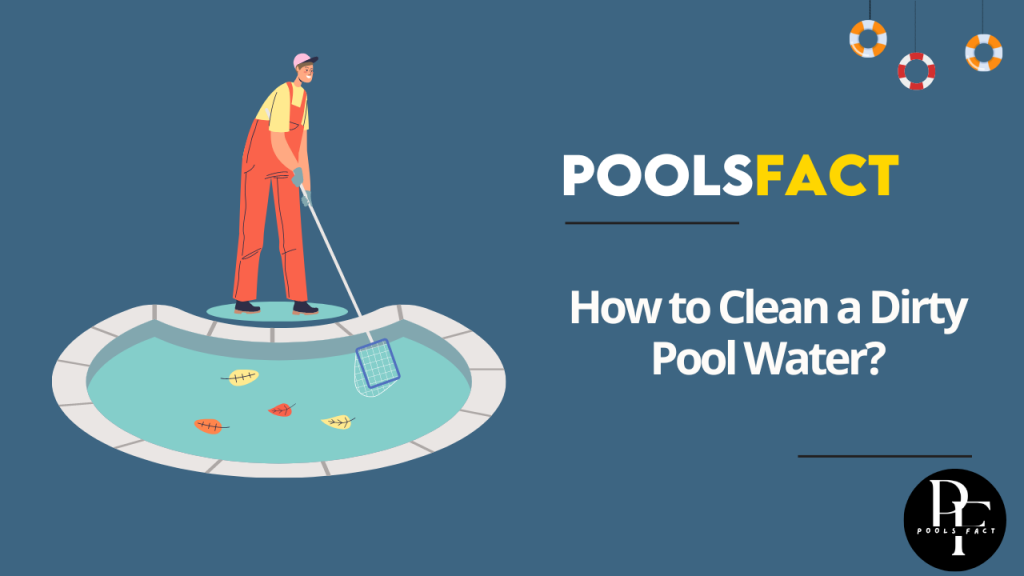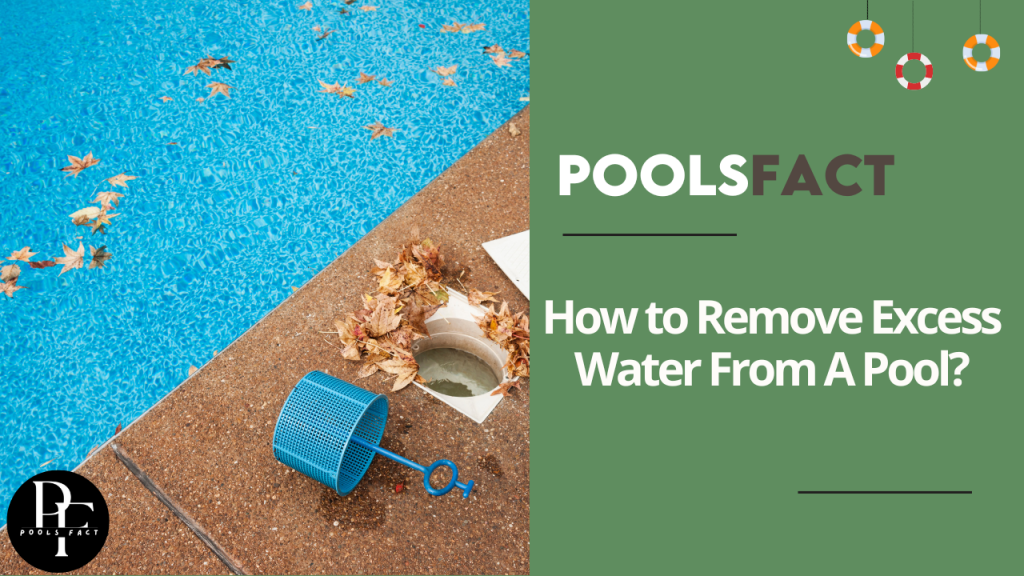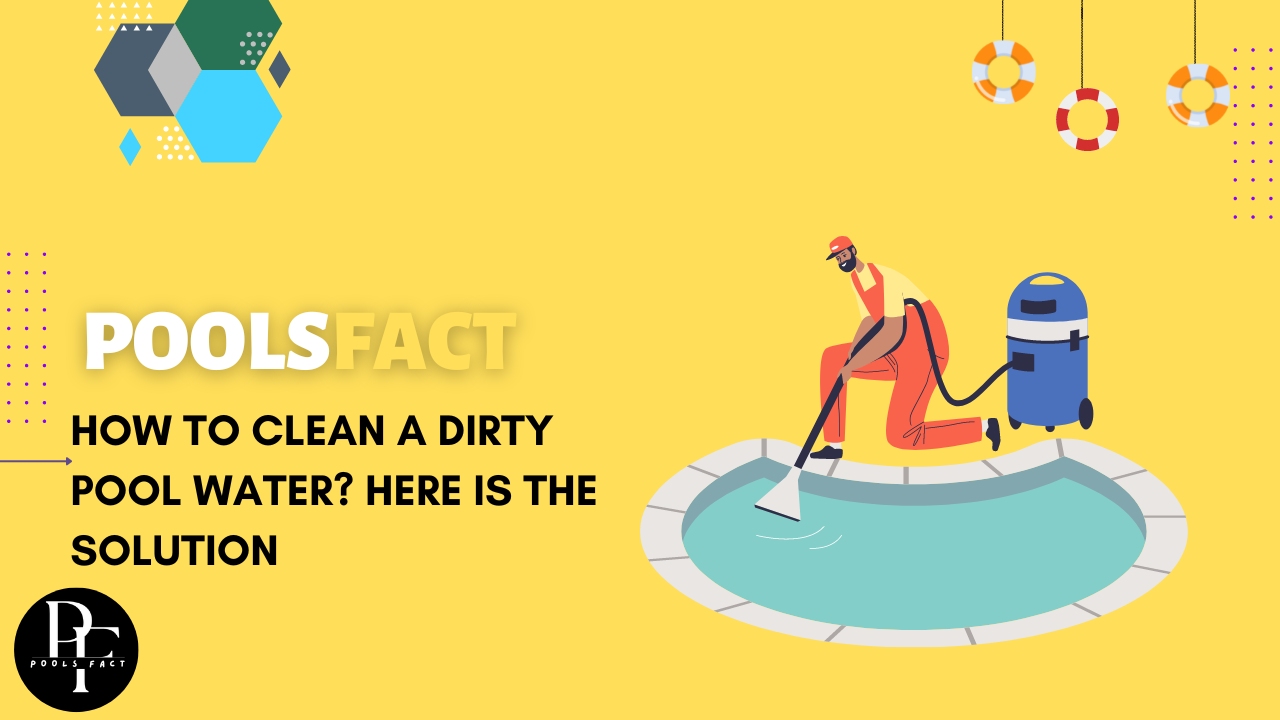Have you ever seen storm clouds roll in and been terrified by the thought of what your pool would look like when the rain stops and the sun comes out? It’s every pool owner’s worst fear to have mud and filth wash into their pool after a storm.
Here, we simplify the process of sanitizing your pool following a rainstorm.
How to Clean a Dirty Pool Water?
Debris, insects, leaves, and dirt are all in swimming pools. Your pool could be harmed by this debris. If dirt isn’t removed, it might clog your pool’s filters, which can then damage your pump and other hardware.
A pool net, pool vacuum, or filtration system can be used to clean a dirty pool water. Keep in mind, though, that a pool filter won’t do much good in a flooded pool since the silt particles are too small.

Method #1: Clean Your Dirty Pool Water Without Empty It
Step 1. Clean the pool outside
Always clean the perimeter of the deck or pool first before focusing on the problem itself. Keep the pool clean so that dirt, mud, and other debris don’t make a mess.
Step 2: Wipe the Water’s Surface Using a Skimmer Net
Use a skimmer to manually remove as much floating trash as you can from the pool’s water as you make your way around the entire pool. Instead of trying to vacuum it up later, it’s far simpler to just skim it off now. That way, the skimmer basket stays unclogged as well.
Step 3. Toss in A Lot of Chlorine
It’s important to increase chlorine levels quickly once a large amount of organic debris has entered your pool. This will help maintain the pool’s water level and lessen the chance that fallen leaves and other debris will discolor the pool floor.
Chlorine levels can be increased from 0 to 30 ppm by adding liquid chlorine. Add some stabilizers to slow the chlorine’s decomposition.
Step 4. Use a Vacuum to Remove Debris from The Pool Floor
Most likely, the rain will have also deposited a variety of dirt, leaves, and debris onto the floor of your pool.
A pool vacuum cleaner is required for further cleaning after using the skimmer. It’s important to promptly remove any dirt or muck that may have accumulated on the pool’s surface.
Use a leaf vacuum like this one, which is powered by a garden hose, to pick up huge pieces of trash. This model’s huge debris bag eliminates the need for frequent emptying. And it can be powered by a garden hose, so you may use it even if your pool doesn’t have its own filtration system.
Today we’ll look into water filtration systems. Filters are used to remove smaller particles, whereas skimming is used to remove larger waste. Filtering will help remove the dark hue that has settled in your pool.
How do air filters function, exactly? Filtration systems for swimming pools are very efficient mechanical processes that remove debris from the water. The water is drawn into the filter container, where it passes through the filter medium (often sand, diatomaceous earth (DE), or a cartridge).
By doing this, the filter media is able to keep the clean water from the pool and return it to the pool while the debris and silt are contained in the media. If you have muddy water, you’ll need to backwash or clean your filter often.
To know when it’s time to clean your filter, keep an eye on the filter pressure indicator.
Vacuuming, skimming, and filtering should be done in rotation. The water should be clear after a few days of this process.
Step 6. Clear the Water by Adding Flocculant
Even after several days of cleaning and vacuuming, the water in your pool may still have a brownish hue. The water is cloudy and appears brown because microscopic particles are still floating in it.
The use of a skimmer, vacuum, or filter is unlikely to be effective in removing these particles of dirt and muck. Here is where the scientific research comes in handy. A substance known as a flocculant is available.
After being treated with flocculant, a muddy pool’s fine mud particles will clump together and sink to the pool’s floor.
Now, we can use the vacuum to get rid of this trash and the filter to clean the water even more.
Test-Balancing the Water
All the sediment should have been removed, and your water should be clear. It’s time for another water quality test. In addition to making sure your water has the right amount of pH, chlorine, alkalinity, and cyanuric acid, you should also test for these things. The finest pool testing kits may be purchased here.
Also Read: Do You Need a Permit for A Pool? If Needed How to Apply
How to Remove Excess Water From A Pool?
After everything around your pool has dried up completely, you can drain it.

Step 1. Make Sure Your Pool Pump Is Unplugged
Don’t forget to cut off the power to the pool’s electrical components before you start cleaning. As the last step, connect your drain hose and have it ready to empty. There shouldn’t be any problem with the hose length between your pool and the submersible pump.
Step 2: Place the end of the hose into the pool and turn on the pump
Submerge the hose in the pool and activate the pump. If you want to avoid a short circuit, you should always use a GFCI (ground-fault-Circuit-Interrupter) outlet to power your pump.
Step 3. You’ll Need to Hold Off until The Water Has Drained
Leave the pump and hose running to drain the pool, but do check on it occasionally. To avoid the pool pump from drying out and breaking, you’ll need to check on it frequently. The average drain time for a pool is 14 hours. The length of time required to drain your pool, however, will be proportional to its size.
Also Read: How Close Can a Pool Be to A House? Install It Like a Pro
Conclusions
It’s frustrating that dirt and muck constantly find their way into pools despite the fact that they require extensive cleaning. However, if you have some fundamental abilities and time on your hands, you can handle this at home.
Frequently Asked Questions (FAQs)
How Do I Get the Brown out Of My Pool Water?
The remedy for greenish-blue water induced by excessive copper levels is comparable to the remedy for reddish-brown pool water. According to the label’s instructions, add a chemical for metal control sequestration to your water. Then, operate your pump and filter for 24 hours while re-testing for metal content.
Will Chlorine Clean a Dirty Pool Water?
In order to kill bacteria, chlorine is added to the water. But it takes some time to start working. Free chlorine*, when utilized correctly, has a short kill time for the majority of microorganisms. The CDC advises keeping pools’ pH between 7.2 and 7.8 and hot tubs’ and spas’ free chlorine levels between 1 and 3 ppm.
What Do You Put in Dirty Pool Water?
If your pool is exceptionally bad, it can need MANY gallons of liquid chlorine (shock) spread out over several days until the water becomes clear. Start by adding 3 or 4 gallons, and if you don’t observe any changes the next day, add 3 or 4 more gallons.
Why Is My Pool Returning Dirty Water?
If dirt is leaking back into the pool, it may be a sign that the filter needs to be back washed since it is blocked and dirty. Backwashing is required when the pressure gauge climbs by eight to ten pounds per square inch (PSI) above its respective normal working range.
Why Is My Pool Still Dirty After Cleaning?
Sand gets smaller and finer over time, and these particles can readily slip through the filter as time goes on. This may be a major factor in the pool’s continued filthiness even after vacuuming. Another sign that the sand is being changed is that the water is noticeably cloudier than usual.

Leave a Reply